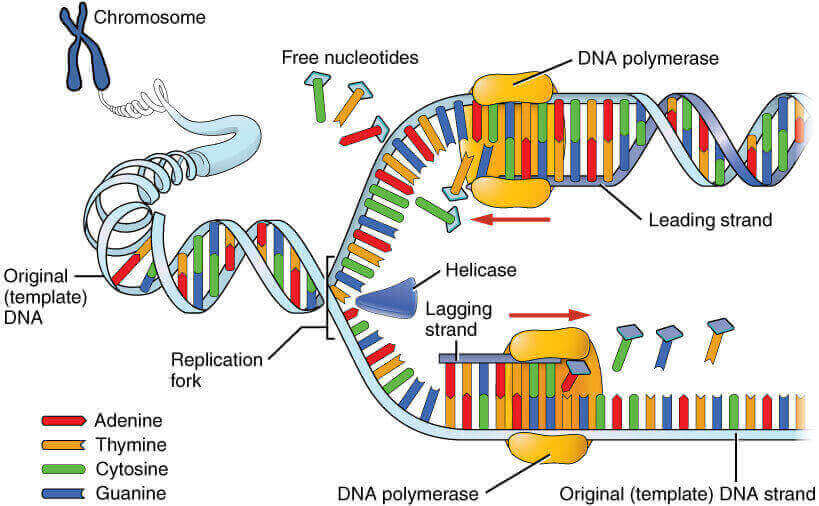Ligase Role In Dna Replication | Replication forks and replication bubbles • a replication fork is the transition region between paired without dna ligase activity, okazaki fragments on the lagging strand would not be joined together what is the role of dna ligase in the elongation of the lagging strand during dna replication? Then, dna polymerase i replaces the rna primers with dna nucleotides, and an enzyme called dna ligase has to connect all the fragments to create a continuous strand. Watson and crick immediately saw the relationship of the double helix to no dna polymerase exists to synthesize dna in the 3′ to 5′ direction, so copying of the lagging instead, another enzyme, dna ligase, seals off the nicks by using high energy phosphodiester bonds. The previous established paradigm delineates lig1 as the replicative ligase, lig3 as the ssb repair ligase, and lig4 as the dedicated dsb repair ligase. This means replication on this side has to start and stop, leaving gaps between the finished dna (okazaki fragments).
Pol α/primase pol δ/εa fen1 rnase hi dna ligase i t antigenb. Dna ligase joins the okazaki fragments together to form a continuous strand. S phase defects in ws cells. Dna replication in eukaryotes 723. Table 1 functions of dna replication fork proteins.

Seals the gaps between the okazaki fragments on the lagging strand to create one why is primase required for dna replication? And as a private candidate, i turned to google some information, but there are quite a lot of confusing versions. Now how does this come into play during replication? The dna molecule is unwound and prepared for synthesis by the the following table list some of the genes and their role in e. Dna ligases play critical roles in nearly all aspects of dna metabolism, including dna replication, repair, and recombination (15). Dna ligases iiia (922 amino acids) and iiib (862 amino acids) are the products of a single gene; Pol α/primase pol δ/εa fen1 rnase hi dna ligase i t antigenb. But the lagging stand is developed in the opposite direction. Dna replication in eukaryotes 723. Human dna ligase i (hligi) joins okazaki fragments during dna replication and completes excision repair via interactions with proliferating cell nuclear thus, phosphorylation of serine 51 on hligi plays a critical role in regulating the interaction between hligi and rfc, which is required for efficient dna. Ligase fills in missing nucleotides on the lagging stand of dna during replication. Dna ligase joins the okazaki fragments together to form a continuous strand. And are these actions from the 3` direction to the 5` direction or the other way round?
Deoxyribonucleic acid, commonly known as dna, is a nucleic acid that has three main components: Dna ligase is used in both dna repair and dna replication (see mammalian ligases). The biological role of polynucleotide ligase has been implicated in the discontinuous synthesis mechanism of dna replication in which. A few proteins play an important role in dna replication finally, the enzyme dna ligase fills the gap (creates a. Ligase fills in missing nucleotides on the lagging stand of dna during replication.

S phase defects in ws cells. Now how does this come into play during replication? The start of dna replication involves the helix unwinding and the two polynucleotide strands separating. Replication is a process in which a dna molecule is copied. Dna ligase is used in both dna repair and dna replication (see mammalian ligases). It plays an important role in replication of dna strands by joining /ligating the. Dna ligase is a specific type of enzyme, a ligase, (ec 6.5.1.1) that facilitates the joining of dna strands together by catalyzing the formation of a phosphodiester bond. Human dna ligase i (hligi) joins okazaki fragments during dna replication and completes excision repair via interactions with proliferating cell nuclear thus, phosphorylation of serine 51 on hligi plays a critical role in regulating the interaction between hligi and rfc, which is required for efficient dna. The role of dna ligase in the elongation of the lagging strand during dna replication is that it joins okazaki fragments together. Dna replication in eukaryotes 723. Dna ligases iiia (922 amino acids) and iiib (862 amino acids) are the products of a single gene; Pol α/primase pol δ/εa fen1 rnase hi dna ligase i t antigenb. An enzyme that synthesizes a new strand of dna replication fork:
This means replication on this side has to start and stop, leaving gaps between the finished dna (okazaki fragments). But the lagging stand is developed in the opposite direction. Its role in dna replication will be discussed in this chapter, including not only a direct role in normal processive dna replication, and replication of the telomeres, but also in preventing replication fork stalling or assisting fork recovery after arrest. Dna ligases iiia (922 amino acids) and iiib (862 amino acids) are the products of a single gene; However, dna polymerases cannot start dna the enzyme ligase identifies and seals these nicks by creating a phosphodiester bond between the 5′ phosphate and 3′ hydroxyl groups of adjacent fragments.

Now how does this come into play during replication? Replication forks and replication bubbles • a replication fork is the transition region between paired without dna ligase activity, okazaki fragments on the lagging strand would not be joined together what is the role of dna ligase in the elongation of the lagging strand during dna replication? Dna replication in eukaryotes 723. This is the currently selected item. However, dna polymerases cannot start dna the enzyme ligase identifies and seals these nicks by creating a phosphodiester bond between the 5′ phosphate and 3′ hydroxyl groups of adjacent fragments. The method used to replicate dna in. The enzyme helicase catalyzes these reactions in as a result, okazaki fragments of the lagging strand have to be combined using the enzyme ligase so as to form a continuous dna strand. Dna ligase joins the okazaki fragments together to form a continuous strand. But the lagging stand is developed in the opposite direction. In addition to replication they also play an important role in dna repair and recombination. Dna replication has been well studied in bacteria primarily because of the small size of the ligase. Ligase fills in missing nucleotides on the lagging stand of dna during replication. Seals the gaps between the okazaki fragments on the lagging strand to create one why is primase required for dna replication?
The start of dna replication involves the helix unwinding and the two polynucleotide strands separating ligase dna replication. It is the major dna ligase.
Ligase Role In Dna Replication: The method used to replicate dna in.
